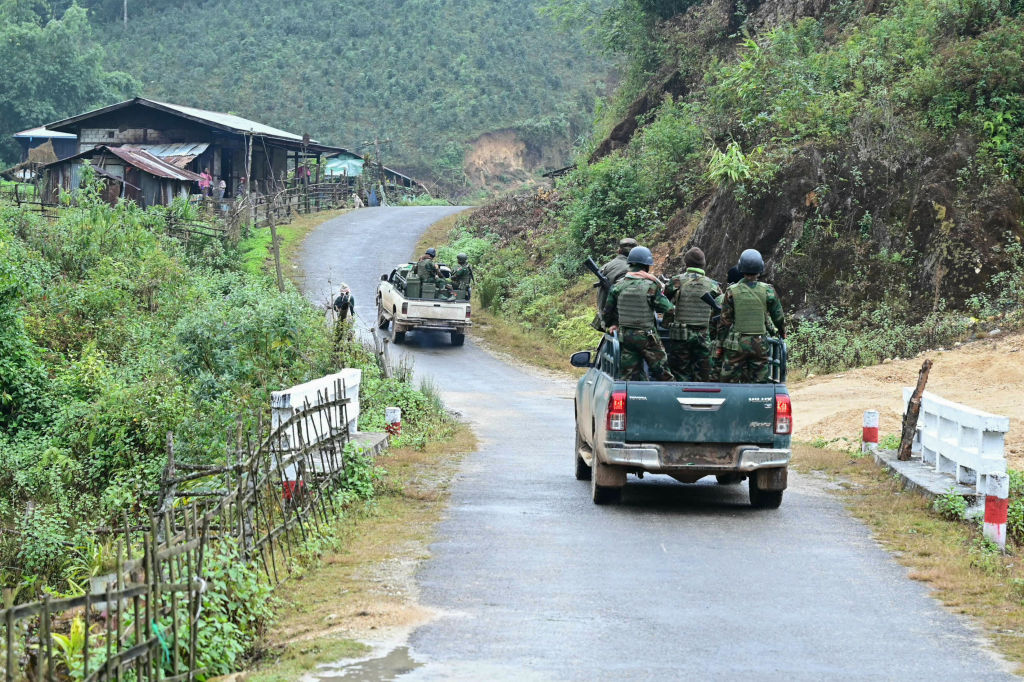
As the Israel–Hamas war rages, the dire humanitarian situation in Gaza is grabbing headlines—as well it should. But another armed conflict, in Myanmar, is also causing mass suffering, with more than two million people internally displaced and over a million more streaming into neighbouring Bangladesh, India and Thailand. And it’s attracting far less international attention.
This is not to say that outside forces aren’t engaged in the conflict in Myanmar. On the contrary, the United States seems to view supporting the rebel and pro-democracy groups attempting to overthrow the military junta—which returned to power in a February 2021 coup—as a kind of moral test. But its approach is doing Myanmar little good.
After the military overthrew Myanmar’s nascent civilian government—to which it had begun ceding power barely six years earlier—US President Joe Biden’s administration reimposed wide-ranging sanctions, which it has since ratcheted up. But, so far, the sanctions have left Myanmar’s military elites relatively unscathed, even as they have unravelled the economic progress made over the past decade and inflicted misery on ordinary citizens.
The Biden administration has also deepened engagement with the so-called National Unity Government that was formed as an alternative to the junta. Though the US, like the rest of the world, has refrained from formally recognising the shadow government, that hasn’t stopped the Biden administration from providing ‘non-lethal aid’ to its notional army, the People’s Defence Force, as well as to ethnic insurgent organisations and pro-democracy groups, under the BURMA Act. And the US has a history of interpreting ‘non-lethal’ rather loosely. Non-lethal support for Syrian rebels, for example, included enhancing their operational capabilities on the battlefield.
The groups the Biden administration supports in Myanmar don’t share a common cause, let alone a single political strategy. The shadow government has failed to win the support of all major ethnic groups, and its armed wing lacks a unified military command. The ethnic insurgent groups—some of which have records of brutality—are often more interested in securing autonomy for their communities than in building an inclusive federal democratic system, and some are willing to collaborate with the junta to get it. Complicating matters further, these groups’ territorial claims sometimes overlap.
It’s impossible to say for certain whether growing US aid flows have fuelled more violence in Myanmar. But there’s no doubt that rebel attacks have lately intensified, with serious consequences not only for civilians, who often are caught in the crossfire, but also for neighbouring states. Just last month, a major offensive—which enabled the rebels to gain control of several border towns and dozens of military outposts—drove at least 72 government soldiers to flee to India in just one week. The junta responded by intensifying its own lethal force, including punitive air strikes and artillery barrages.
Meanwhile, more than 32,000 ethnic Chin from Myanmar have taken refuge in India’s Chin-majority Mizoram state, where they live mostly in refugee camps. Thousands more have fled to another Indian border state, Manipur, fuelling an increasingly violent conflict between the local population’s two main ethnic groups.
US aid to armed groups around the world has often fuelled disorder and suffering, undercutting the quest for democracy. Judging by Myanmar’s deteriorating humanitarian situation, it seems that this may well be happening again. And Myanmar’s neighbours are being affected in much the same way the US would be affected if faraway powers sought to punish Mexico and aid rebel groups there. Yet, far from letting the neighbouring countries take the lead in setting policy towards Myanmar, the Biden administration has insisted they toe the US line.
America’s uncompromisingly punitive approach to Myanmar’s military junta has hopelessly divided the 10-country Association of Southeast Asian Nations, preventing it from playing a constructive role in the conflict. Paradoxically, the US has sought to co-opt ASEAN to promote democracy in Myanmar, even though the majority of the group’s members remain under authoritarian rule.
India, the world’s most populous democracy, is increasingly concerned that the US approach is pushing resource-rich Myanmar into China’s arms. India not only shares long land and sea borders with Myanmar, but also views the country as a strategic corridor to Southeast Asia. Given the cross-border movement of people and guerrillas—some trained and armed by China—close counterinsurgency cooperation with Myanmar is vital for India’s security.
Biden’s misguided Myanmar policy seems to align with his public rhetoric about a ‘global battle between democracy and autocracy’. But elsewhere, his administration has adopted a more pragmatic foreign-policy approach, deepening strategic relations with non-democracies in order to counter China’s growing influence. For example, during the G20 summit in New Delhi in September, Biden sought to mend ties with Saudi Arabia. He then visited Vietnam, calling it a ‘critical Indo-Pacific partner’.
Such realism should be welcomed: if the promotion of democracy and human rights overrode all other considerations, US diplomacy would have very few partners outside the West. But this approach needs to be extended to Myanmar. The US would stand a better chance of helping to end direct military rule there by opening up lines of communication with the junta and offering it incentives to reverse course.
It was the abandonment of a failed sanctions policy in favour of calibrated US engagement that helped bring about the formal end of Myanmar’s military dictatorship in 2015. If Myanmar is to avoid becoming a failed state, the Biden administration must adopt a similar strategy today.

